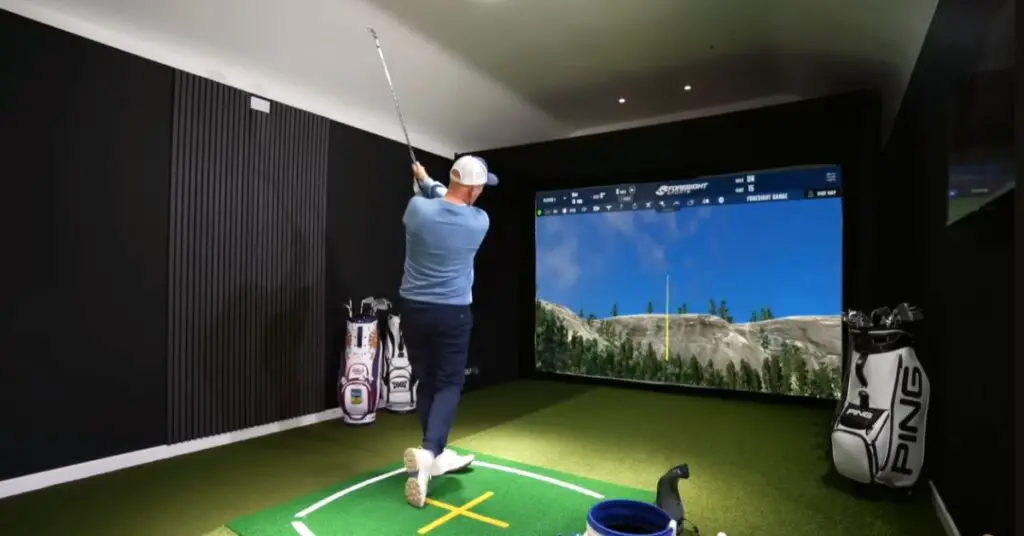How to Build a Golf Simulator for the Ultimate Home Experience!
Are you a golf enthusiast looking to improve your swing or simply enjoy the game year-round, no matter the weather? If so, a golf simulator is a perfect solution for you. Imagine playing a round of golf anytime, right in the comfort of your own space.
In this article, we’ll show you how to build a golf simulator from scratch, providing all the necessary components and steps to create an immersive, realistic golfing experience. From choosing the right hardware to setting up the software, we’ve got you covered.
Keep reading to discover the secrets behind creating your own golf simulator, as well as helpful tips and recommendations to ensure that your setup is functional and enjoyable. Your dream golf simulator is just a few steps away!

Materials and Equipment Needed To Build Golf Simulator
You need several essential components to build a golf simulator for an accurate, immersive, and enjoyable experience. Here’s a list of the crucial components and an explanation of each:
Launch Monitor or Golf Simulator Unit
The launch monitor or golf simulator unit serves as the heart of any golf simulator, tracking and analyzing your shots.
Radar or infrared technology gathers data such as clubhead speed, ball speed, launch angle, spin rate, and more. Popular launch monitors include TrackMan, SkyTrak, and FlightScope.
Golf Hitting Mat
You need a high-quality golf mat to mimic real turf and provide a consistent surface for striking the ball.
The mat should be durable, withstand repeated use, and offer accurate feedback on shots. Opt for mats with realistic tee placements and a balance between forgiveness and durability.
Golf Hitting Net or Impact Screen
A hitting net or impact screen catches golf balls safely after you hit them. Hitting nets offer more portability and affordability, while impact screens deliver a more immersive experience by projecting the simulated golf course. Choose a durable, high-quality net or screen to prevent damage to your surroundings.
Projector (optional)
You’ll need a projector if you want to display the virtual golf course on an impact screen. Select a projector with adequate brightness, contrast, and resolution for a crisp, vibrant image.
Short-throw projectors work well in limited spaces, projecting large images from a short distance.
Computer or Tablet
You need a computer or tablet to run the golf simulator software, which processes data from the launch monitor and shows the simulated golf course.
Make sure your device meets the system requirements of your chosen software. Some launch monitors, like SkyTrak, can connect directly to tablets.
Golf Simulator Software
The golf simulator software creates a virtual golf environment, including courses, practice modes, and game modes.
Examples are The Golf Club (TGC), E6 Connect, and Creative Golf 3D. Make sure the software works with your launch monitor and computer or tablet.
Enclosure or Golf Simulator Room
An enclosure or dedicated room creates a safe and contained environment for your golf simulator.
The space should accommodate your swing, launch monitor, and any projection equipment. Consider the ceiling height, room length, and room width when planning your setup.
Turf or Flooring
A suitable flooring solution provides safety and aesthetics. Golf-specific turf or padded flooring offers a comfortable, non-slip surface for golfers while protecting your floors from damage.
Side and Ceiling Netting (optional)
Installing netting on the sides and ceiling of your simulator space adds extra protection and helps contain stray shots, especially if you use a hitting net instead of an impact screen.
Audio System (optional)
An audio system can enhance your golf simulator experience by providing realistic sound effects and background music. Choose a system that fits your space and desired audio quality.
Step-by-step guide for setting up a golf simulator
Setting up a golf simulator involves several steps, including choosing the right space, selecting the components, assembling the simulator, and configuring the software.
Here’s a step-by-step guide to help you set up a golf simulator at home or in your office:
step 1: Choose the right space
Ensure you have a suitable area for the simulator. A minimum of 10 feet in width, 15 feet in length, and 9 feet in height are recommended, although more space is ideal for a comfortable swinging experience.
step 2: Assemble the components
Follow these steps to assemble your golf simulator:
- Set up the frame and enclosure: Assemble the frame and enclosure according to the manufacturer’s instructions. Ensure the frame is sturdy and securely anchored to avoid any accidents.
- Install the screen: Attach the impact screen to the frame, making sure it’s tight and wrinkle-free. If you’re using a hitting net instead, set it up according to the manufacturer’s guidelines.
- Position the projector: Mount the projector on the ceiling or place it on a projector stand. Ensure it’s aligned with the center of the screen and at the correct distance to achieve optimal image quality.
- Set up the golf mat: Place the golf mat in front of the screen or net, ensuring its level and secure. This is where you’ll be standing and taking your shots.
- Install the launch monitor: Position the launch monitor according to the manufacturer’s guidelines, typically behind or beside the golf mat. Ensure it has a clear view of the ball and club throughout the swing.
step 3: Connect the components:
Once everything is in place, connect the launch monitor, projector, and computer. Ensure all cables are safely routed to avoid any tripping hazards.
step 4: Install and configure the software
Install the simulator software on your computer, and follow the setup wizard to configure your system.
This will typically involve selecting your tracking device, calibrating the software to your specific setup, and adjusting any other settings.
step 5: Test and fine-tune
Test your simulator by taking a few practice shots. Observe the data’s accuracy, the projected image’s alignment, and the system’s overall performance.
Make any necessary adjustments to the projector, launch monitor, or software settings.
step 6: Accessorize and enjoy
Add desired accessories, such as a ball tray, club rack, or turf, to complete your setup.
Once you’re satisfied with your golf simulator, invite some friends over and enjoy your new indoor golf experience!
What features should A golf simulator software have?
Now, we guess you can build your own golf simulator. But is every software perfect for your requirements? How should you choose the appropriate simulator software?
When looking for golf simulator software, it’s essential to consider the following features to ensure you have an enjoyable and realistic golfing experience:
Graphics and realism
High-quality graphics and realistic visuals are essential for an immersive experience. Look for software that offers detailed course renderings and accurate terrain modeling.
Course selection
A wide variety of golf courses, including famous and lesser-known ones, will keep the experience fresh and engaging. Some simulators offer the option to download additional courses or create custom ones.
Swing analysis and feedback
Good golf simulator software should provide comprehensive feedback on your swing, including clubhead speed, launch angle, ball spin, and more.
This will help you identify areas for improvement and track your progress over time.
Customization and adjustability
The software should allow you to adjust various settings, such as weather conditions, tee positions, green speed, and course difficulty, to tailor the experience to your preferences and skill level.
Multiplayer options
If you want to play with friends, either locally or online, ensure that the software supports multiplayer functionality.
Practice modes and mini-games
In addition to regular gameplay, look for software that offers practice modes and mini-games to help you hone specific skills and add variety to your sessions.
Integration with hardware
Ensure that the software is compatible with your specific golf simulator hardware, such as launch monitors, cameras, and sensors.
Some simulators come with proprietary software, while others allow you to choose from third-party options.
Regular updates and support
Look for frequently updated software with new courses, features, and improvements.
Regular updates indicate that the developer is actively maintaining and enhancing the product.
Additionally, reliable customer support is essential for addressing any issues or questions you may have.
User interface and ease of use
A user-friendly interface and intuitive navigation will make setting up and enjoying your golf simulator easy.
Look for software that is easy to install, has clear instructions, and offers customizable settings.
Performance and system requirements
High-quality golf simulator software may have higher system requirements, especially in terms of graphics and processing power.
Ensure your computer or device meets the minimum requirements to run the software smoothly without any performance issues.
Price and value for money
Golf simulator software can vary in price, so consider your budget and the features you value most.
Remember that investing in high-quality software can significantly enhance your overall golf simulator experience.
User reviews and reputation
Research online reviews and testimonials to learn about other user’s experiences with the software.
This will give you an idea of the software’s reliability, performance, and overall user satisfaction.
Problems you may face when building golf simulator
Building a golf simulator can be an exciting project for golf enthusiasts, but it also comes with its own set of challenges. Some problems you may face when building a golf simulator include:
Space constraints
Golf simulators require significant space to accommodate the swing, screen, projector, and other equipment.
You need a room with a high ceiling and sufficient depth and width to accommodate a realistic golfing experience.
Budget limitations
High-quality golf simulators can be expensive, with costs ranging from a few thousand to tens of thousands of dollars.
You’ll need to consider the costs of the launch monitor, hitting mat, impact screen, projector, software, and any additional accessories.
Technical expertise
Building a golf simulator requires some technical knowledge and skills, including assembling various components, setting up the software, and ensuring proper calibration.
If you’re not tech-savvy, you may need assistance from a professional or a knowledgeable friend.
Software compatibility
Not all golf simulation software is compatible with every launch monitor or computer system.
You’ll need to research and choose the right software that works with your hardware and meets your needs.
Calibration and accuracy
Ensuring that your simulator provides accurate measurements and feedback requires proper calibration and setup.
This process can be complex, involving aligning the projector, adjusting launch monitor settings, and fine-tuning the software.
Lighting conditions
Golf simulators rely on accurate readings from the launch monitor, which can be affected by poor lighting.
Make sure your simulator space has consistent and well-distributed lighting to ensure accurate data capture.
Noise and vibration
Golf simulators can generate significant noise and vibration due to club impact and ball striking the screen.
You may need to consider soundproofing or noise reduction measures, especially if the simulator is in a residential area or shared space.
Maintenance
Golf simulators require regular maintenance, such as updating software, cleaning the screen, and inspecting the hitting mat and other components for wear and tear. Neglecting maintenance can lead to decreased performance and accuracy.
Safety concerns
Ensure the simulator area is clear of any hazards, and consider installing safety nets or other protective measures to prevent damage to your equipment or surroundings from errant shots.
Realism and immersion
While a golf simulator aims to replicate the real golfing experience, it may not perfectly simulate factors such as wind, elevation changes, and course conditions.
It’s essential to manage your expectations and understand the limitations of a simulator compared to playing on an actual course.
Is it worth building golf simulators?
Whether it is worth building a golf simulator depends on your goals, budget, and target audience.
Golf simulators can be beneficial in various ways, but they also come with some drawbacks.
Here are some points to consider when deciding if building a golf simulator is worth it for you:
Purpose
Determine why you want to build a golf simulator. Is it for personal use, for a commercial venture, or as an addition to an existing facility? Understanding your purpose will help you decide if it’s worth the investment.
Cost
Golf simulators can be expensive, with costs ranging from a few thousand dollars for basic setups to tens of thousands for high-end models.
Factor in the cost of installation, maintenance, and any additional equipment or accessories needed.
Space requirements
Golf simulators require a dedicated space with enough room for a player to swing a golf club. Ensure you have the necessary space available before committing to building a simulator.
Skill improvement
Golf simulators can provide valuable feedback on your swing, clubface angle, ball trajectory, and other aspects of your game. This can help golfers of all skill levels improve their performance on the course.
Weather-independent practice
Golf simulators allow you to practice your game regardless of the weather or time of day, making them an excellent option for those living in areas with variable weather conditions or limited daylight hours.
Entertainment value
Golf simulators can be an entertaining addition to homes or commercial establishments, offering guests a unique and engaging experience.
Return on investment
If you’re building a golf simulator for commercial purposes, consider the potential revenue it could generate.
Will the simulator attract more customers and justify the cost of installation and maintenance?
Maintenance and Upkeep of the golf simulator
As a golf simulator owner, ensuring its longevity and maintaining its performance quality is crucial.
In this section, we will focus on the maintenance and upkeep of a golf simulator to keep it in excellent condition for years to come. Maintenance and Upkeep Guide:
Keep the simulator area clean
Regularly clean the area around the simulator to prevent dust and dirt buildup. Vacuum the hitting mat and surrounding area to remove debris, which can affect the sensors’ accuracy.
Wipe down the screen, projector, and other surfaces with a damp cloth to remove dust and fingerprints.
Inspect and adjust tension cables
Check the tension cables on the impact screen to ensure they are taut and secure.
Loose wires can lead to a sagging screen, affecting image quality and causing the ball to bounce back unpredictably. Adjust the tension cables as needed to maintain a smooth, even surface.
Check the projector alignment and focus
Ensure that the projector is aligned correctly with the screen and maintain its focus for optimal image quality. Regularly check for any image distortion or blurring and make necessary adjustments.
Clean the projector filter
Most projectors have a removable filter that traps dust and debris. Clean the filter according to the manufacturer’s recommendations to prevent overheating and prolong the projector’s life.
Inspect sensors and cameras
Clean the sensors and cameras using a soft, dry cloth or compressed air. Check for any signs of damage or malfunction, and address issues promptly to maintain accurate tracking and performance.
Update software and firmware
Keep the simulator software and firmware up-to-date to ensure optimal performance and compatibility.
Regular updates can improve tracking accuracy, fix bugs, and add new features.
Monitor turf and hitting mat wear
Over time, hitting mats and turf can wear down, affecting performance and ball bounce.
Inspect them regularly for signs of wear and replace them as needed to maintain a consistent playing surface.
Calibrate the system
Regularly calibrate your golf simulator to ensure accurate ball flight data and club measurements.
Follow the manufacturer’s instructions for the calibration process, which may include adjusting sensors, cameras, or software settings.
Inspect and maintain hardware
For wear or damage, regularly inspect all hardware components, including the computer, cables, and connections.
Keep cables organized and secure to prevent accidental disconnections or damage. Address any issues promptly to maintain optimal performance and avoid downtime.
Ensure proper ventilation and climate control
Golf simulators produce heat, especially from the projector and computer. Ensure that the room has proper ventilation and air conditioning to prevent overheating and maintain a comfortable user environment.
Protect against power surges
Use surge protectors to safeguard your golf simulator’s electrical components from voltage spikes and power surges.
This can help prolong the life of your equipment and prevent costly repairs or replacements.
Perform routine backups
Regularly back up your simulator’s data, including player profiles, custom courses, and settings.
This will protect your data in case of hardware failure or accidental deletion and make it easier to restore your system if needed.
Schedule annual professional maintenance
Schedule an annual checkup with a qualified technician who specializes in golf simulators.
They can identify and address potential issues, ensuring that your system remains in top condition for years.
Establish usage guidelines
Set clear guidelines for proper simulator usage to prevent damage and maintain the equipment’s longevity.
Encourage users to follow basic rules, such as wearing clean golf shoes, not hitting balls with excessive force, and being mindful of the equipment while playing.
FAQs
What is the cost of building a golf simulator?
The cost of building a golf simulator can vary greatly depending on the components you choose.
A basic setup with a portable launch monitor and a simple hitting mat can start around $1,000.
However, a more advanced system with a high-quality projector, impact screen, tracking system, and software can range from $10,000 to $50,000 or more.
Can I build a golf simulator outdoors?
While it is possible to build a golf simulator outdoors, it is not recommended due to potential issues with weather, sunlight, and temperature fluctuations.
These factors can damage sensitive equipment, such as projectors and tracking systems, and affect your simulator’s overall performance and longevity.
For the best results, choose an indoor location with controlled environmental conditions.
Can I play against friends and other players using my golf simulator?
Yes, many golf simulator software options offer multiplayer capabilities, allowing you to play with friends either locally or online.
Check the software’s features to ensure it supports multiplayer functionality if this is an important aspect for you.
How can I improve my golf skills using a simulator?
Golf simulators provide valuable feedback on your swing, ball flight, and overall performance.
Analyze the data, identify areas for improvement, and use the simulator’s practice modes and mini-games to target specific skills.
Additionally, consider using online tutorials or hiring a golf instructor to guide technique and strategy.






![How Does Putting Work On Golf Simulator? [Ultimate Guide] How-Does-Putting-Work-On-Golf-Simulator](https://giftedgolfers.com/wp-content/uploads/2023/01/How-Does-Putting-Work-On-Golf-Simulator-300x157.jpg)